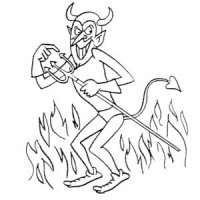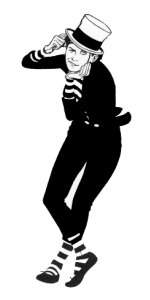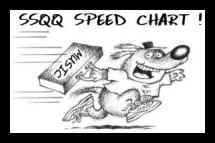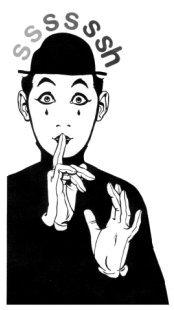So,
tonight is your first night to Western Dance in the Real World...
A great song comes on. Your
date smiles at you hopefully. You ask her to dance and get out of your chair.
Suddenly the thought flashes, "What the Devil do I dance to this ?"
If you are a total Beginner,
take a guess what it is, then do the opposite. Just kidding. Sort of just kidding.
One timeless secret is to
watch a more experienced dancer first, then copy him. Or try what you think it is. If it
doesn’t fit the music, just smile and switch to another dance. Trial and error has
its place. Or swallow your pride and ask your date. Women always seem to know.
|
 |
Most of all, cheer up. There is no reason
to be embarrassed if you haven’t got a clue. Most people new to dance classes are not
familiar with how the dances fit the music. Very few Beginners know a Twostep from a Polka
from a Waltz. I certainly didn't when I started. That is one reason people take lessons.
If it makes you feel any
better...
I was crazy enough to teach Two-step
and Polka before I even knew what song fit which dance. I was teaching Disco in 1979 when
"Urban Cowboy" literally wiped Disco off the planet overnight. Here in Houston I
realized if I wanted to eat, I had better learn this Western stuff fast. A lady named
Joanne, one of my Disco students, knew how to Western dance, but she didn’t know the
boy’s part or how to explain the footwork.
Although it is embarrassing to
reveal this, I scheduled a Western class before I even had a clue how to dance a Twostep
or a Polka. I prayed Joanne would be able to teach me how fast enough that I could turn
around and teach it. I just hope surgeons don't use a similar preparation method...
For the first couple weeks I
was barely one step ahead of my class. In order to play music, I had to ask Joanne to play
all the music since I myself did not know a Twostep from a Polka from a Waltz. Oh
well, I didn't cripple anyone.
|

|
Eventually I caught on and so will
you.
The Practice Nights we have at SSQQ
right after each class go a long way towards clearing this hurdle. You can watch what the
other dancers try to each song and there are always plenty of people standing around that
you could ask. Everybody in the place was a Beginner at some point and they remember how
it feels to be a little lost. Feel free to ask !
The 10-Second Trick
By practicing, many people
learn to "feel" what dance fits the music. If you prefer a more analytical
method, I believe a good place to start is to learn how to count the speed of a song. You
can practice this on your car radio or your CD player.
First you need to find out
what the "Speed" of your song is. This is known as the "Beats Per
Minute". Now put on a song and try to identify the strongest beat of the music.
Next keep your eye on the second hand of your watch.
Count the beats
for 10 seconds, then multiply times 6 to get the Beats Per Minute.
Although using more time (ie,
20 seconds, 30 seconds) will give a more precise count,
10 seconds will get you close enough to identify what speed range you are in.
Now compare the speed of
your song with the chart. Go ahead and click the Speed Chart. See where the song you
counted fits on the Speed Chart and what dances are listed in that range. This should give
you a strong idea what dance it is.
THE SPEED CHART
Every dance has a speed range
measured by BEATS PER MINUTE (BPM). The middle of this range is the speed where a dance,
e.g. Cha-Cha (120), feels the most comfortable. |

|
The 3 Major Speed Ranges
|
Slow Range :
Triple Step Range :
Slow/Quick Range :
|
075 - 100 bpm
100 - 150 bpm
150 - 200 bpm (and 75 - 100 bpm) |
Here's an important Secret !
THE SLOW RANGE AND THE QUICK RANGE ARE OFTEN THE SAME !
Music timed in the 75-100
Range is often equivalent to the 150-200 Range.
For example, using "Mack
the Knife" from the Speed
Chart,
we see it is listed at two different speeds, 78 and 156 bpm.
|
The reason is that many
uptempo songs like Bobby Darin's 1959 Swing classic "Mack the Knife" have two
different rhythms going at the same time, a foreground beat and a background beat.
When listening to
"Mack", I counted the strongest beat and got the number 13 (now multiply 13
times 6 to get 78 bpm).
When I counted again, I counted the quicker background beat.
This time I came up with 26 beats (26 times 6 equals 156). Some people prefer to say
"Mack the Knife" is 78 beats per minute. Others say "Mack the Knife"
is 156. Guess what ? They are both right !
The strongest beat
(foreground) is considered the "Slow Beat".
The background tempo is considered the "Quick Beat".
Up-tempo music is placed
in the Slow/Quick Range
|
 |
Sometimes a Slow Song
turns out to be a Slow Song !
Just because two songs are
timed at 78 bpms doesn't mean they have the same feel. Many songs have only one distinct
tempo going. For example, the classic Sam Cooke Slow Dance song "Only You" may
technically be the same speed as "Mack", but it sure feels different because as
a Slow Dance song it lacks a background beat. There is literally only one distinct tempo
to count.
"Mack the Knife" has
a speed listing in both the Slow Range and the Quick Range so it is considered an up-tempo
song. "Only You" is only listed in the Slow Range so it is considered a
slow-tempo song.
When you are counting music it
never hurts to double the number you came up with or divide your number by two to get an
extra clue as to what dance might work best to a particular song.
Slow Music belongs in the
Slow Range (duh!)
On Page of our
Speed of Music writeup we explore the Triple Step Range of 100-150 beats per minute. Many famous dances such as Polka,
Jitterbug, Lindy, ChaCha, Merengue, Whip, and West Coast Swing are danced to music found
in this range.
|
 |
|
|
|
|
|
|